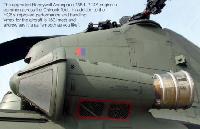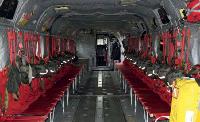Фотографии
-
Hovering at 90ft with any barely any references to put down a load - or undertake a confined area landing - is made easier by the HC6’s D-AFCS.
Самолёты на фотографии: Boeing-Vertol CH-47 Chinook - США - 1961
-
One of eight 'fat-tank' HC3s undertakes a dust landing on the Salisbury Plain Training Area. D-AFCS de-risks environmental operations issues such as this. The HC3’s planned Julius AFCS upgrade has been held back to complete both the Julius and D-AFCS cockpit enhancements in one hit.
Самолёты на фотографии: Boeing-Vertol CH-47 Chinook - США - 1961
-
RAF Odiham confirmed that the final legacy Chinook HC2 recently entered the Project Julius AFCS enhancement programme. The only legacy cockpit aircraft remaining are the HC3s.
Самолёты на фотографии: Boeing-Vertol CH-47 Chinook - США - 1961
-
Group Captain Richard Maddison OBE, RAF Odiham's station commander and UK Chinook Force CO, said the HC6’s introduction is going extremely well.
Самолёты на фотографии: Boeing-Vertol CH-47 Chinook - США - 1961
-
CDF team members, left to right: Flt Lt Christian Hilliker, Master Aircrew Paul Holmes and Sqn Ldr Adam Shave.
Самолёты на фотографии: Boeing-Vertol CH-47 Chinook - США - 1961
-
Регистрационный номер: ZA675 The rear crewman’s role is vital and their confidence in performing confined area landings has been boosted because the helicopter can now be moved in 1 foot increments, keeping the swing very low.
Самолёты на фотографии: Boeing-Vertol CH-47 Chinook - США - 1961
-
The upgraded Honeywell Aerospace T55-L-714A engine is common across the Chinook fleet. In addition to the HC6's improved performance and handling, Vmax for the aircraft is 160 knots and aircrew say it is as "smooth as you like".
Самолёты на фотографии: Boeing-Vertol CH-47 Chinook - США - 1961
-
Регистрационный номер: ZK552 Chinook HC6 ZK552 above the Hampshire countryside near its Odiham base, following its public introduction on June 16 last year.
Самолёты на фотографии: Boeing-Vertol CH-47 Chinook - США - 1961
-
The Selex Titan 385 ES-HD FLIR Multi-Sensor Turret, mounted on the aircraft closest to the camera, combines high-performance UK mission-specific sensors such as D-NVG into a single line replaceable unit.
Самолёты на фотографии: Boeing-Vertol CH-47 Chinook - США - 1961
-
As well as an additional seat, the new rear crewman station has the same tablet-based pre-flight mission planning system as the cockpit.
Самолёты на фотографии: Boeing-Vertol CH-47 Chinook - США - 1961
-
The Chinook has room for up to 55 troops.
Самолёты на фотографии: Boeing-Vertol CH-47 Chinook - США - 1961
Статьи
- -
- News
- A.Drwiega - Lifting the Lid on the Phantom Swift /Technology/
- A.Spaeth - The Gulf Trendsetter /Commercial/
- C.Kjelgaard - A New Global Strategy /Commercial/
- C.Kjelgaard - Towards Tomorrow's United States Fighter Engine /Technology/
- D.Unwin - Thoroughbred TBM /Commercial/
- I.Harding - Chinook Mark Six /Military/
- J.Lake - Saudi's Super Eagle /Military/
- M.Broadbent - Breaking the Ice /Technology/
- P.Butowski - Air Parade /Military/
- P.Butowski - Standstill or Respite? /Military/










